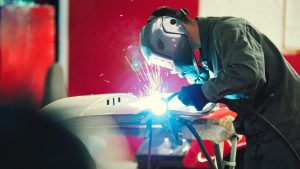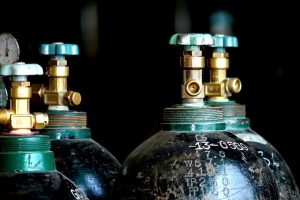When mig welding steel, the gas that you use is important. The shielding gas is used to keep the weld clean. Some steels do not require the use of shielding gas when they are welded with flux-cored wire. There are several different types of gas mixes and all of them do slightly different things. The right gas mix for you will depend on the thickness of your workpiece and the type of metal you are welding.
What gas is best for MIG welding steel?
MIG welding uses several gases, including argon and helium. While these two gases are the most commonly used, others may have similar properties and produce similar results. It is essential to understand how these gases affect the welding process and choose the right one. Shielding gases, for example, set the atmosphere for the weld and protect the workpiece from contamination.
Pure Argon is not inert, but it provides some protection against the heat created by the arc. It is best used in a mixture with other shielding gases. Pure CO2 is cheaper than Argon, but it can create a harsher arc and increase the possibility of spattering.
Choosing the right gas for MIG welding is critical to a quality weld. Gases vary in cost and rate and you should study your budget before deciding on a specific gas. Choosing the right gas for your job will ensure a reliable bead pattern and minimize heat generation. If you’re not sure, contact the manufacturer of your welder for more information.
MIG welding uses a shielding gas, which helps keep the weld clean and minimize weld spatter. Most metals respond well to a 75/25 mix of argon and carbon dioxide. However, some metals require more argon than others. A general rule of thumb is that argon/CO2 mixtures are best for welding steel.
Can you mig weld steel with 100 argon?
Argon is a gas that has a low ionization potential, limiting its ability to generate an arc and therefore, decrease the power of the welding arc. As a result, the arc tends to be weaker, resulting in weaker weld beads and poor bead contours. Pure argon also decreases the ductility of the welded joint, making it susceptible to cracking and breaking. Hence, it is not advisable to use argon during MIG welding.
The use of 100% argon to MIG weld mild steel is only recommended as a last resort. In addition to producing weaker and brittle weld joints, it also reduces the thermal conductivity of the metal. Furthermore, it creates a small, narrow cavity in the metal, which is susceptible to breakage. It is also prone to spatter.
The main disadvantage of 100% argon to MIG weld steel is that it causes spatter and has a lower penetration depth than 75/25. In addition, 100% argon welding is ineffective for welding thicker metals. To avoid such problems, you can use an appropriate argon line system. A pressure regulator should be installed on the argon line. This regulator will help you reduce the flow rate to 15-30 psi.
What gas is used for steel welding?
When welders are performing MIG welding on steel, the gas used is usually argon-carbon dioxide. This mix contains about 50 percent argon and the other half is carbon dioxide. This gas is known as a shielding gas and is essential to the welding process. It will help prevent overheating and produce a consistent beat pattern. A good way to choose the right gas for your job is to refer to the manufacturer’s recommendations.
Helium is the most expensive gas and requires a higher flow rate than argon. The added cost of helium should be weighed against the increase in productivity. Helium is often used in combination with argon and carbon dioxide. Both gases have their advantages and disadvantages, but the gas used should be appropriate for the welding process.
While Argon is the most common gas used for MIG welding, you can use other types of shielding gas as well. Argon is inexpensive and readily available. It has the lowest thermal conductivity of any shielding gas and helps make the weld pool less spattery. Helium, on the other hand, allows for better penetration and a more fluid weld pool. In addition to argon, other gases like carbon dioxide and hydrogen are also used for MIG welding.
Can I use argon for MIG welding steel?
Pure Argon is not suitable for welding stainless steel. However, you can use argon mixed with CO2 for the weld. The downside to pure Argon is that it is not cheap. Using it for welding does not give you the desired weld result. Also, you should be careful with it, as it can be harmful to the weld. Here are some things to remember when using pure Argon.
Carbon Dioxide is not a noble gas like Argon, and thus it can cause damage to the welding steel frame if used alone. However, carbon dioxide can be used with Argon in an appropriate ratio for delicate projects. Carbon Dioxide helps the arc penetrate deeper into the welding material, which results in a stronger bead. However, it can also create a lot of spatter and smoke.
It can also be used to make multiple passes. However, it is not as economical as helium, which is more expensive. In addition, argon can give better protection from oxidation. Helium is also less useful for welding nickel alloys because it can cause micro-pitting and porosity, while argon can provide a better weld. It is possible to mix argon and helium for better results.
How much does argon gas cost?
If you’re considering mig welding, you may be wondering how much argon gas costs. There are several ways to obtain shielding gas, but the most expensive method is by purchasing disposable tanks. However, refilling these tanks is cheaper than purchasing a new one. You can purchase a 60-cf refillable cylinder for as little as $60 and save as much as $300 over the years.
You can find a gas recommendation guide from your welding wire manufacturer. Usually, they will have guidelines that indicate the best gas for a particular project. In addition, the manufacturer of your welding equipment will usually provide a guide detailing the recommended gas and electrode combinations for your project.
Alternatively, you can choose a mix that combines 2% Argon and 75 percent CO2. The ratio of these two gases can vary, but both provide a smooth weld and reduce spatter. Some of the more common mixes are C25 (75% Ar, 25% CO2), and trimix 72/25/3 Ar/CO2/He.
The amount of gas required for a typical MIG weld can range from 25 to 30 cubic feet per hour (CFH), with larger cylinders requiring higher flow rates. The amount of gas used depends on the type of welding machine and the working environment. If the work area is windy, a higher flow rate is recommended to prevent air bubbles. Even a slight breeze can cause a weld to fail.
Is argon or CO2 better for MIG welding?
MIG welding steel requires the proper mixture of gases to achieve the desired results. A combination of argon and carbon dioxide gives a smoother output, a deeper penetration and just the right amount of heat for bending the steel. This combination makes the process of welding steel easier and more productive.
Helium is more expensive than argon, but it has certain benefits. It resists chemical reactions and produces a lower amount of weld spatter. It is often mixed with argon and CO2 to make welding more affordable. It is mostly used for non-ferrous metals, but it is also sometimes added to stainless steel to produce an arc that’s safer.
The decision to use argon or CO2 for welding depends on your welding process, the thickness of the steel, and your budget. For instance, argon-heavy gases are better for stainless steel welding and spray transfer welding. Argon-heavy gas is ideal for welding steel that’s thin, while helium-heavy gases are ideal for short circuits and spray transfer welding. The choice depends on your budget, but both gas types can perform equally well.
CO2 has several disadvantages over argon, but is cheaper and more durable. It is also easier to clean. Moreover, because of its lower oxygen content, CO2 has less porosity. Most alloy steels and metals can be welded with either gas.
Originally published at xpressmobilewelding.com




No comments:
Post a Comment